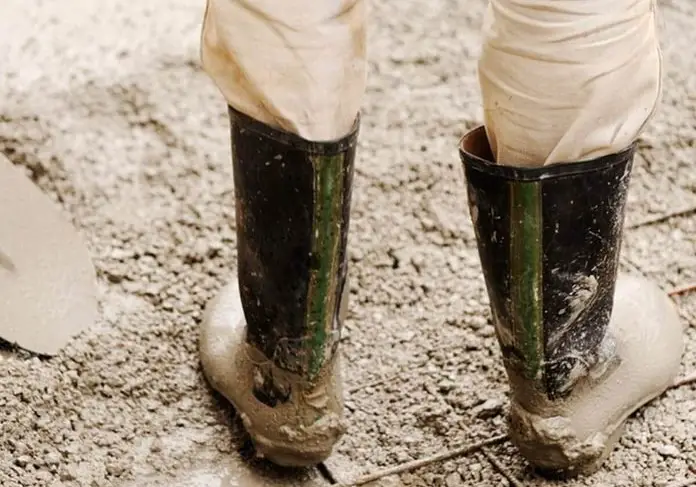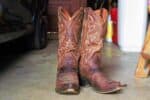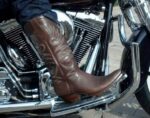Muck boots are lightweight, comfortable, and easily fit into the shape of your leg making them all the more convenient. They are seen as the perfect walking buddy for short walks, working in the muddy garden, or for a taxing hiking trip.
All that said, muck boots might have even more to offer. Yes, that is true. You might have heard how some say that these soft boots can withstand the effect of concrete. Well, is this true?
This blog is going to look into the same. So, read and explore!
Although muck boots are made with a chemical-resistant material called neoprene, they will deteriorate when touched with concrete as not the whole boot is made with the material.
Chemicals in concrete can result in the shell of the boot cracking and breaking with time. Hence, it is better to choose those types that are crafted especially for wet industrial works.

Does concrete have a significant effect on the boot materials?
I am not going to tell you about the history of concrete or how it is made. But, to understand the answer to this question you ought to know certain facts about concrete.
Concrete is used in construction for that strength that can hold up immense weights and keep the traction to the core thereby preventing the structure from colliding.
To gain this characteristic, the concrete mix is produced with the inclusion of certain chemicals that come as part of the cement that is used.
Bonding agents, corrosive inhibitors, defoamers, pigments, retarders, plasticizers, pumping aids are some of the chemicals included in the concrete mix.
The effect of concrete on your skin is well known. If concrete gets hardened on your skin, it can lead to second and third-degree burns which will result in blisters, swells, or bleeding.
Likewise, these chemicals can corrode the material that the boots are made of. For instance, synthetic leather cannot withstand the effect of concrete chemicals for it is too soft to handle the harsh ways in which the chemicals work.
Concrete when hardens tend to dry the surface of the boots, resulting in cracks. With time, the leather gets corroded and destroyed. The chemicals thus have a very strong effect on the surfaces.
How muck boots are different from leather boots in terms of quality?
Most of the muck boots are made primarily of a material called neoprene which is a type of synthetic rubber. Made as an oil-resistant alternative to natural rubber, neoprene has many more proven resistive characteristics.
Chemicals are therefore not an issue for the material. Be it any sort of chemical substance, neoprene can easily stay unaffected despite how much concrete or how long it stays on its surface.
Other reasons why neoprene is included in crafting muck boots
1.) Strong exterior against harsh terrains: Yes, this is a major reason why neoprene is considered to be essential in creating a premium quality muck boot.
As muck boots are used for hiking and adventurous experiences, having a strong outer shell is essential for the boots.
2.) Less sensitive to temperature: Unlike natural rubber, neoprene is much less sensitive to temperature. Natural rubber gets sticky or brittle in extreme weather conditions while neoprene does not exhibit this behavior.
3.) Provide insulation for the user: The nature of the material makes it an excellent choice to keep your legs warm and cozy in cold weather to an extent. Hence, most of the users prefer muck boots because of the comfort that they provide.
So, are muck boots safe from the harsh effects of concrete chemicals?
Well…no they are not. Muck boots indeed come in chemical-resistant material as I mentioned above. But, not all the whole boots come finished in neoprene.
Different materials are used for the upper soles, midsoles, and inner soles. Mostly finished in natural rubber, other parts are vulnerable to the effects of chemicals and thereby can easily corrode after concrete splashes.
And this is exactly why you will never find muck boots mentioned as a good option to be used while working in concrete even when it is mostly made of chemical-resistant material.
However, muck boots are seamless and therefore do not allow anything wet to get inside. Therefore you need not worry about your skin getting damaged unless the material becomes brittle or porous after corrosion.
What are the best boots to be used during concrete works?
‘If not leather or muck boots, then what else?’ might be the question that you have now.
Boots that are specially made for construction works are available in the market.
Out of all the sundry types there are, rubber boots are the best option for concrete works. With technological advancements, synthesized rubber nowadays is stronger and comes in high-quality.
Boots fully made of synthesized rubber crafted especially for industrial works should be the ones that you opt for. Like muck boots, these are seamless to prevent concrete from leaking in.
Steel toe boots are one of the best options out there. They are strong, long-lasting, and can withstand the effects of concrete chemicals much better than their competitors. Synthesized rubber will not crack or is not prone to corrosion like leather.
When compared to others, synthesized rubber boots are easy to maintain, carry and have good durability. Moreover, they mold into the leg shape without any difficulty.
To wind up!
Hope you understood why your favorite muck boots might not be the best option for concrete works. But the comfort and coziness offered to make them never go out of demand.
They keep the legs warm and dry even in the wettest of terrains and are therefore irreplaceable in their own way!
If you enjoyed this blog, keep an eye out for the upcoming ones!







